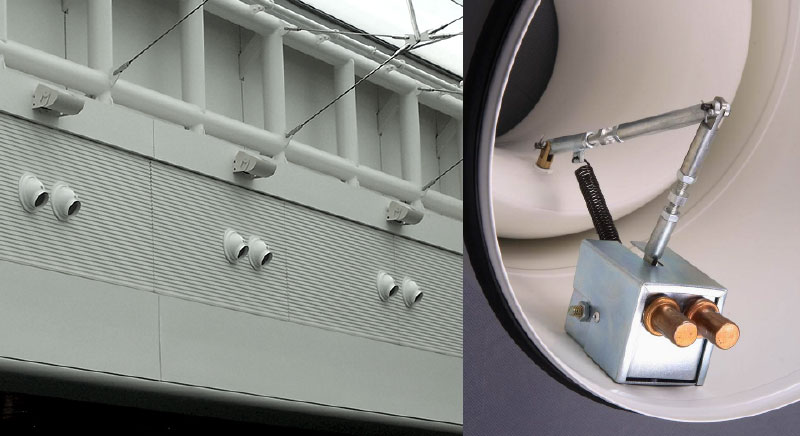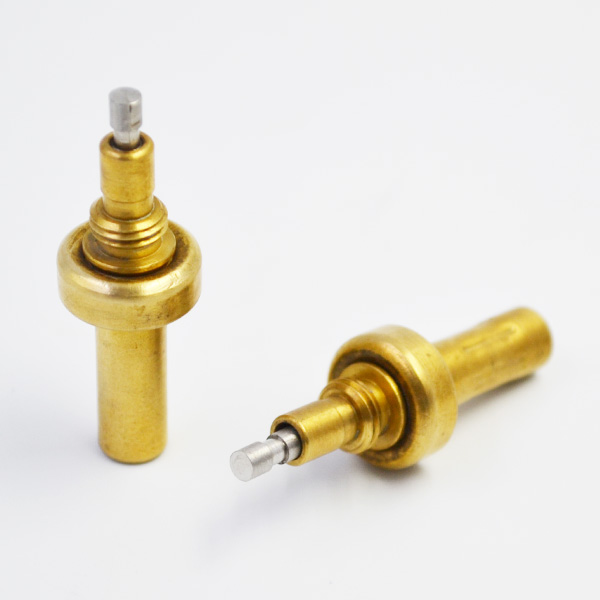This research involves the intelligent waterproof controller of household building, which belongs to the technical field of smart household, including the intake main pipe, which is connected with the toilet branch pipe and the tap branch pipe through the three-way valve. The tap branch pipe is connected with the toilet branch pipe and the kitchen branch pipe through the three-way valve. The electromagnetic valve and the speedometer are installed in each section of the pipeline, and the speedometer is uniform. The input end of the controller is connected with the processing unit and the time unit. The output end of the controller is connected with the solenoid valve, the local alarm and the remote alarm module, respectively. The utility model has the advantages that a small amount of water leakage and a large amount of water leakage can be avoided in the household life, and the water can be intelligently controlled. Smart home control system (SCS) is a smart home control system, which takes smart home system as the platform, takes home appliances and home appliances as the main control object, and comprehensively utilizes integrated wiring technology, network communication technology, security prevention technology, automatic control technology, audio and video technology to make use of the relevant devices in home life. The implementation of efficient integration, so as to build an efficient residential facilities and family schedule affairs control and management system, enhance home intelligence, safety, convenience, comfort, and achieve environmental protection control system platform. Smart home control system is the core of smart home and the basis of the realization of smart home control function. At present, the intelligent home control system mainly consists of the following aspects: intelligent lighting, intelligent electrical appliances, intelligent shading, energy-saving control, remote meter reading, system software, system wiring, system network. Recently, due to the improvement of people’s quality of life, many smart home products developed and utilized in the spirit of “energy saving” have emerged in the market, and developed rapidly, from the high-end, atmosphere, high prices to the trend of civilianization. Home Energy Management System (HEMS) has always been a focus of attention. Then there are many products suitable for general households, such as automatic lighting, power monitoring and equipment efficiency, solar panels, energy-saving renovation of houses and so on. A large number of products originally occupied the market “water-saving controller”, which is used to save water and control the amount of water.

The whole system consists of central processing part, data acquisition part and front-end equipment part. It mainly realizes the function of water-saving controller, which can display by time. Each card can be automatically subsidized for 15-30 minutes a day.
The number of times of use is not limited and displayed in a time-decreasing manner. The unique water-saving design uses the dual mode of reading and switching to control the water. After inserting the card, the boiling water key is pressed, the card is removed or the water-closing key is pressed to stop the water-out. It is more humane and water-saving; its main principle is to reduce the flow power, increase the flow pressure in the pipe, thermostatic element and use the principle of lever to operate the water control valve. Its main waterproof measures are the use of waterproof material design for the shell, the use of waterproof connectors at the entrance and exit of the data line, and the use of asbestos between the bottom cover and the top cover first pressed in the groove at the junction. Main board and chip are laid with waterproof wax, wiring requirements and repair are carried out synchronously.
It is the best way to walk in the wall and play a safe role. If the wall can not be reformed, pipeline wiring can be used. It can be used in the main water use of household daily life, which can play the role of water saving, but it can not reach the creation concept of smart home, there is no integrated design, there is no intelligent embodiment. At present, water conservation is being publicized everywhere. On the one hand, it can save natural resources and benefit the long-term development of human beings. On the other hand, it can save water consumption and household expenses. However, in the home life, there are still some problems which are easy to cause the waste of domestic water: First, the damage of water equipment is easy to cause the waste of water, such as kitchen, toilet faucet, toilet toilet, etc. When the above components fail, they usually show a small amount of running water or dripping water, which is difficult to detect, but the time is limited. In the long run, the amount of wasted water is also very serious; second, the water pipeline in the home is broken, or the water supply forgot to close the tap after the water shutdown. Under the above circumstances, there will be a large amount of running water, especially when all the members of the family go out, the amount of wasted water is more serious, and it is easy to cause damage to the floor and furniture immersed in water. In order to solve the above technical shortcomings, the utility model provides an intelligent waterproof controller for household buildings, which can avoid the trouble of a small amount of water leakage and a large amount of water leakage in household life, and can intelligently control water. The technical scheme of the study is as follows: an intelligent waterproof controller for household buildings includes a water intake main pipe, which is equipped with a main pipe solenoid valve and a main pipe flow meter; the main pipe is connected with a toilet branch pipe and a faucet branch pipe through a three-way valve, and the faucet branch pipe is connected with a toilet branch pipe and a kitchen branch pipe through a three-way valve; The pipe is connected with a toilet, and the toilet branch pipe is equipped with a toilet solenoid valve and a toilet flowmeter; the toilet branch pipe is connected with a toilet faucet, and the toilet branch pipe is equipped with a water faucet solenoid valve I and a water faucet flowmeter I; the kitchen branch pipe is connected with a kitchen faucet, and the kitchen branch pipe is equipped with a water faucet solenoid valve II and a water faucet flowmeter II. The main pipe flowmeter, toilet flowmeter, faucet flowmeter I and faucet flowmeter II are respectively connected with the input end of the controller, and the controller is equipped with processing unit and time unit. The output end of the controller is respectively connected with the main pipe electromagnetic valve, toilet electromagnetic valve, faucet electromagnetic valve I, faucet electromagnetic valve II and local alarm. Connect with remote alarm module.
In addition, the technical scheme of this study also includes: the local alarm includes a sound alarm installed in the bedroom and/or living room; the remote alarm module transmits the alarm information to the master mobile phone through wireless transmission; and the three-way valve is connected with the main intake pipe, toilet branch pipe and tap branch pipe with a sealing ring.
The beneficial effect of this research is: install the tachometer and solenoid valve on the main pipe, the toilet branch pipe and the tap branch pipe respectively, and connect the tachometer and solenoid valve with the controller respectively. When the velocity value of a tachometer is detected to be greater than 0 but less than the low set value, the controller sends a signal to the solenoid valve action of the corresponding pipeline. The pipeline is closed to avoid a small amount of running water or dripping water caused by toilet or faucet faults; when the velocity value of a flowmeter is detected to be greater than the high setting value, the action of the timing unit in the controller begins to time, and when the flow value of the flowmeter is still greater than the high setting value after the time unit accumulates to the set time, the controller sends out.

In addition, in both cases, the controller triggers local alarm and remote alarm module actions to alert members at home or not at home. Intake main pipe, 11, main pipe solenoid valve, 12, main pipe flowmeter, 2, 3, toilet branch pipe, 4, faucet branch pipe, 41, toilet branch pipe, 42, kitchen branch pipe, 5, toilet, 51, toilet solenoid valve, 52, toilet flowmeter, 6, toilet faucet, 61, faucet solenoid valve I, 62, faucet flowmeter I, 7, kitchen faucet, 71 Faucet solenoid valve II, 72, faucet flowmeter II. The present utility model is further described by means of an embodiment in conjunction with the accompanying drawings.
As shown in Fig. 1 and Figure 2, the intelligent waterproof controller of the household building of the utility model includes an intake main pipe 1. A main pipe solenoid valve 11 and a main pipe flowmeter 12 are installed on the intake main pipe 1. The main pipe solenoid valve 11 is connected with the output end of the controller, and the main pipe flowmeter 12 is connected with the input end of the controller. Intake main pipe 1 is connected with toilet branch pipe 3 and faucet branch pipe 4 through three-way valve 2, and faucet branch pipe 4 is connected with toilet branch pipe 41 and kitchen branch pipe 42 through three-way valve 2. Sealing rings are designed to improve the connection positions of three-way valve 2 with intake main pipe 1, toilet branch pipe 3, faucet branch pipe 4, toilet branch pipe 41 and kitchen branch pipe 42. Reliability of road sealing. The toilet branch pipe 3 is connected with the toilet 5, and the toilet solenoid valve 51 and the toilet flowmeter 52 are installed on the toilet branch pipe 3. The toilet flowmeter 52 is connected with the input end of the controller and the toilet solenoid valve 51 is connected with the output end of the controller. The toilet branch 41 is connected with the toilet faucet 6, and the toilet branch 41 is equipped with the faucet solenoid valve I 61 and the faucet flowmeter I 62. The faucet flowmeter I 62 is connected with the input end of the controller and the faucet solenoid valve I 61 is connected with the output end of the controller. The kitchen branch 42 is connected with the kitchen faucet 7, and the kitchen branch 42 is equipped with the faucet solenoid valve II 71 and the faucet flowmeter II 72. The faucet flowmeter II 72 is connected with the input end of the controller and the faucet solenoid valve II 71 is connected with the output end of the controller. A processing unit and a time unit are designed in the controller. The measured velocity values are transmitted to the controller by the main pipe flowmeter 12, the toilet flowmeter 52, the faucet flowmeter I 62 and the faucet flowmeter II 72, respectively. When the processing unit finds that the velocity values of a certain flowmeter (such as the toilet flowmeter 52) are greater than 0, but less than the low set value, the control is carried out. The device sends a signal to the toilet solenoid valve 51 and closes the toilet branch 3 to avoid the waste of water caused by a small amount of running water or dripping water caused by toilet failure.

When the processing unit finds that the velocity value of a flowmeter (e.g. faucet flowmeter II 72) is larger than the high set value, the timing unit in the controller operates on. When the time unit accumulates to the set time, the flow value of the faucet flowmeter II 72 is still greater than the high set value, the controller sends a signal to the faucet solenoid valve II 71 to close the kitchen branch 42, so as to avoid the large amount of running water caused by the breakdown of the kitchen branch or the forgetting to close the faucet. In addition, an alarm device is designed, specifically including a sound alarm installed in the bedroom and/or living room, which can remind members of the family to deal with a small amount of leakage or running water in time; and a remote alarm module connected with the processing unit, in which the remote alarm module can use GPRS wireless transmission module to handle water accidents in the home.
Barrier information is transmitted to the host’s mobile phone. Author’s brief introduction: Wenling, female (1981.10-), Han nationality, Tacheng people of Xinjiang, lecturer, master’s degree, mainly from the physical, electronic information, intelligent building education and teaching work. Wang Lei, male (1979.1-), Han, Xinjiang, lecturer, master, mainly engaged in software engineering, embedded technology and other aspects of education.
